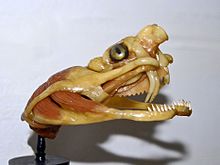
Back سم الأفعى Arabic İlan zəhəri Azerbaijani Hadí jed Czech Schlangengift German Veneno de serpiente Spanish Maomürk Estonian زهر مار Persian Käärmeenmyrkyt Finnish Veleno de cobra Galician सांप का विष Hindi

Snake venom is a highly toxic saliva[1] containing zootoxins that facilitates in the immobilization and digestion of prey. This also provides defense against threats. Snake venom is usually injected by unique fangs during a bite, though some species are also able to spit venom.[2]
The glands that secrete zootoxins are a modification of the parotid salivary glands found in other vertebrates and are usually located on each side of the head, below and behind the eye, and enclosed in a muscular sheath. The venom is stored in large glands called alveoli before being conveyed by a duct to the base of channeled or tubular fangs through which it's ejected.[3][4]
Venom contains more than 20 different compounds, which are mostly proteins and polypeptides.[3][5] The complex mixture of proteins, enzymes, and various other substances has toxic and lethal properties.[2] Venom serves to immobilize prey.[6] Enzymes in venom play an important role in the digestion of prey,[4] and various other substances are responsible for important but non-lethal biological effects.[2] Some of the proteins in snake venom have very specific effects on various biological functions, including blood coagulation, blood pressure regulation, and transmission of nerve or muscle impulses. These venoms have been studied and developed for use as pharmacological or diagnostic tools, and even drugs.[2][5]
- ^ "Reptile Venom Research". Australian Reptile Park. Archived from the original on 2 February 2010. Retrieved 21 December 2010.
- ^ a b c d Bauchot R (1994). Snakes: A Natural History. New York City, NY, USA: Sterling Publishing Co., Inc. pp. 194–209. ISBN 978-1-4027-3181-5.
- ^ a b Halliday A, Kraig T, eds. (2002). Firefly Encyclopedia of Reptiles and Amphibians. Toronto, Canada: Firefly Books Ltd. pp. 202–203. ISBN 978-1-55297-613-5.
- ^ a b Bottrall JL, Madaras F, Biven CD, Venning MG, Mirtschin PJ (September 2010). "Proteolytic activity of Elapid and Viperid Snake venoms and its implication to digestion". Journal of Venom Research. 1 (3): 18–28. PMC 3086185. PMID 21544178.
- ^ a b Oliveira, Ana L.; Viegas, Matilde F.; da Silva, Saulo L.; Soares, Andreimar M.; Ramos, Maria J.; Fernandes, Pedro A. (July 2022). "The chemistry of snake venom and its medicinal potential". Nature Reviews Chemistry. 6 (7): 451–469. doi:10.1038/s41570-022-00393-7. ISSN 2397-3358. PMC 9185726. PMID 35702592.
- ^ Mattison C (2007). The New Encyclopedia of Snakes. New Jersey, USA (first published in the UK): Princeton University Press (Princeton and Oxford) first published in Blandford. p. 117. ISBN 978-0-691-13295-2.